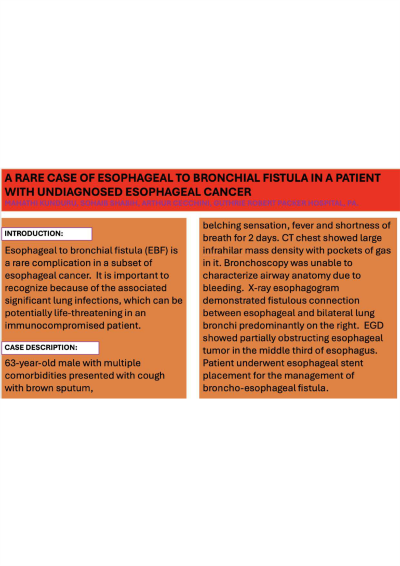Tuesday Poster Session
Category: Esophagus
P4018 - A Rare Case of Esophageal to Bronchial Fistula in a Patient With Undiagnosed Esophageal Cancer
Tuesday, October 29, 2024
10:30 AM - 4:00 PM ET
Location: Exhibit Hall E

Has Audio

Mahathi Kunduru, MD
Guthrie Robert Packer Hospital
Sayre, PA
Presenting Author(s)
Mahathi Kunduru, MD, Sohaib Shabih, MD, Arthur Cecchini, MD
Guthrie Robert Packer Hospital, Sayre, PA
Introduction: Esophageal to bronchial fistula (EBF) is a rare complication in a subset of esophageal cancer. It is important to recognize this condition because of the associated significant lung infections, which can be potentially life-threatening in an immunocompromised patient. We present a case of undiagnosed esophageal cancer presenting with esophageal to bronchial fistula.
Case Description/Methods: 63-year-old male with past medical history significant for stage IV metastatic lung cancer, on chemoradiation, peripheral vascular disease, type 2 diabetes presented with cough with brown sputum, belching sensation, fever and shortness of breath for 2 days prior to presentation. Patient was admitted for management of possible multifocal vs aspiration pneumonia, and was on treatment with IV antibiotics. CT chest showed multifocal airspace opacities and large infrahilar mass density with pockets of gas in it. Bronchoscopy with BAL was done due to abnormal CT findings. Bronchoscopy was unable to characterize airway anatomy due to bleeding during the procedure. X-ray esophagogram demonstrated fistulous connection between esophageal and bilateral lung bronchi predominantly on the right. EGD showed partially obstructing esophageal tumor in the middle third of esophagus. Patient underwent esophageal stent placement for the management of broncho-esophageal fistula. Patient's symptoms improved after stent placement and was discharged in a stable condition.
Discussion: Esophageal to bronchial fistula (EBF) is a rare condition. The prevalence is not well-documented due to its rarity, but it is known to occur as a complication of various conditions such as malignancies, infections, and inflammatory disorders. The most sensitive diagnostic method is esophagography, followed by esophagoscopy, computed tomography, and bronchoscopy. Barium swallow studies are particularly useful for visualizing the fistula. Management involved a multidisciplinary approach including gastroenterologists, pulmonologists, and thoracic surgeons. For benign EBF, surgical intervention is often required. Treatment options for malignant EBF include esophageal stenting, radiation therapy, and surgical bypass. Esophageal stenting is preferred for immediate relief of symptoms and prevention of aspiration pneumonia. For malignant EBFs, the prognosis is generally poor. The choice of treatment modality significantly impacts survival and quality of life, particularly in malignant cases.
Disclosures:
Mahathi Kunduru, MD, Sohaib Shabih, MD, Arthur Cecchini, MD. P4018 - A Rare Case of Esophageal to Bronchial Fistula in a Patient With Undiagnosed Esophageal Cancer, ACG 2024 Annual Scientific Meeting Abstracts. Philadelphia, PA: American College of Gastroenterology.
Guthrie Robert Packer Hospital, Sayre, PA
Introduction: Esophageal to bronchial fistula (EBF) is a rare complication in a subset of esophageal cancer. It is important to recognize this condition because of the associated significant lung infections, which can be potentially life-threatening in an immunocompromised patient. We present a case of undiagnosed esophageal cancer presenting with esophageal to bronchial fistula.
Case Description/Methods: 63-year-old male with past medical history significant for stage IV metastatic lung cancer, on chemoradiation, peripheral vascular disease, type 2 diabetes presented with cough with brown sputum, belching sensation, fever and shortness of breath for 2 days prior to presentation. Patient was admitted for management of possible multifocal vs aspiration pneumonia, and was on treatment with IV antibiotics. CT chest showed multifocal airspace opacities and large infrahilar mass density with pockets of gas in it. Bronchoscopy with BAL was done due to abnormal CT findings. Bronchoscopy was unable to characterize airway anatomy due to bleeding during the procedure. X-ray esophagogram demonstrated fistulous connection between esophageal and bilateral lung bronchi predominantly on the right. EGD showed partially obstructing esophageal tumor in the middle third of esophagus. Patient underwent esophageal stent placement for the management of broncho-esophageal fistula. Patient's symptoms improved after stent placement and was discharged in a stable condition.
Discussion: Esophageal to bronchial fistula (EBF) is a rare condition. The prevalence is not well-documented due to its rarity, but it is known to occur as a complication of various conditions such as malignancies, infections, and inflammatory disorders. The most sensitive diagnostic method is esophagography, followed by esophagoscopy, computed tomography, and bronchoscopy. Barium swallow studies are particularly useful for visualizing the fistula. Management involved a multidisciplinary approach including gastroenterologists, pulmonologists, and thoracic surgeons. For benign EBF, surgical intervention is often required. Treatment options for malignant EBF include esophageal stenting, radiation therapy, and surgical bypass. Esophageal stenting is preferred for immediate relief of symptoms and prevention of aspiration pneumonia. For malignant EBFs, the prognosis is generally poor. The choice of treatment modality significantly impacts survival and quality of life, particularly in malignant cases.
Disclosures:
Mahathi Kunduru indicated no relevant financial relationships.
Sohaib Shabih indicated no relevant financial relationships.
Arthur Cecchini indicated no relevant financial relationships.
Mahathi Kunduru, MD, Sohaib Shabih, MD, Arthur Cecchini, MD. P4018 - A Rare Case of Esophageal to Bronchial Fistula in a Patient With Undiagnosed Esophageal Cancer, ACG 2024 Annual Scientific Meeting Abstracts. Philadelphia, PA: American College of Gastroenterology.
